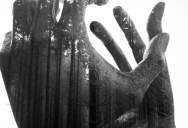Picture of the Day: A Gripping Double Exposure
A GRIPPING DOUBLE EXPOSURE
In this incredible double exposure by Florian Imgrund, we see his hands cast against an incredible shot of the forest. It’s an incredible effect and the composition is truly gripping. Florian states that this shot was an analogue double exposure meaning the effect was created entirely in camera and not in post-production in a program like Photoshop.
In photography, double exposure is a technique in which a piece of film is exposed twice to two different images. The resulting photographic image shows the second image superimposed over the first. The technique can be used to create ghostly images or to add people and objects to a scene that were not originally there.
It is considered easiest to have a manual winding camera for double exposures. On automatic winding cameras, as soon as a picture is taken the film is typically wound to the next frame. Some more advanced automatic winding cameras have the option for multiple exposures but it must be set before making each exposure. Manual winding cameras with a multiple exposure feature can be set to double-expose after making the first exposure.
Since shooting multiple exposures will expose the same frame multiple times, negative exposure compensation must first be set to avoid overexposure. For example, to expose the frame twice with correct exposure, a ?1 EV compensation may have to be done, and ?2 EV for exposing four times. This may not be necessary when photographing a lit subject in two (or more) different positions against a perfectly dark background, as the background area will be essentially unexposed.
Medium to low light is ideal for double exposures. A tripod may not be necessary if combining different scenes in one shot. In some conditions, for example, recording the whole progress of a lunar eclipse in multiple exposures, a stable tripod is essential. More than two exposures can be combined, with care not to overexpose the film. [Source: Wikipedia]
Trending on TwistedSifter

Parents Emotionally Manipulated Grandparent Into Babysitting For 5 Days, So They Took The Kids To Disney Without The Parents




